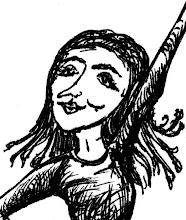

An assignment I have done with several classes this year is a figure sculpture assignment. Students create a miniature figure using tinfoil, plaster bandages, plaster, and paint. Some have turned out really well. For many students it is an enjoyable project because they get to use different materials, and each step along the way is a little bit different, so every class brings something new, there isn't time to get bored with it(for most of them...).
Starting with a lesson on doing some figure sketching, I then lead into the project. Depending on the time I have with each class I may spend more time drawing the figure and focusing on that before starting on the sculpture assignment.
Supplies needed:
tinfoil
plaster bandages
plaster of paris
paint
primer
Pieces of wood to use as a base
nails or screws
sandpaper
1. To begin students are to decide on a emotion, or theme that they want to express with the body language of their figure. They then do a few sketches to get their ideas down and so that there is a goal in mind.
2. They start with a piece of tinfoil about 1 foot or a foot and a half long. I found that thicker tinfoil works best, and you won't need as much for the whole class. Make several slits in the tinfoil as a basic template as to where the arms and legs, and head goes. Smush, crumple, and shape the tinfoil into the shape of a person. Be careful about proportions, thickness and height.
3. Attach tinfoil character onto a nail on the wooden base. You may need more that one nail to keep it steady and free from wobbling. Sometimes I will have students attach the tinfoil to the screw threw the calf, and then add another nail where the foot will go so that you can build up the foot around the nail.
4. Cut plaster bandages into strips up to an inch wide, and about 5 inches long. Dip in water and cover tinfoil with bandages. You will probably need at least 2 layers of bandages. Make sure that where the weight of the sculpture is there is enough layers of bandages so that it cannot bend or break.
5. Use plaster of Paris to fill in any gaps, or to smooth out areas. Let dry.
6. Take Sandpaper and sand down any areas.
7. Prime sculpture with acrylic primer. If you don't prime it the paint will end up flaking off of the bandages.
8. Paint sculpture with acrylic paint.
Sometimes I need to add some glue to keep the sculpture from wobbling or moving around. Glue gun glue works well for this. I have also done this project using chicken wire instead of tinfoil, but found that it was too hard to shape. Tinfoil allows for more details. If you went larger then chicken wire might be needed.
Figure Sculpture Evaluation
Use of materials: The figure was built up well. The student makes good use of the materials. The student followed directions on creating a sculpture base, using plaster bandages, plaster and paint. The student demonstrated skill in the use of these materials. Figure structure is sturdy. Student has learned the basics of sculptural design.
1 2 3 4 5 6 7
Proportions, Figure stance, Theme and Creativity The figure shows emotion or the theme it was intended to express. The figure is proportionally accurate, or the proportions of the figure add to the significance of the theme. Sculpture demonstrates creativity.
1 2 3 4 5 6 7 8
Final Product, Process and Workmanship: The final result of the figure is interesting to look at. The colours and the paint enhance the sculpture. The student has demonstrated neatness and accuracy. The student has demonstrated consideration for all aspects of this piece. The student has shown skill in creating a 3-dimensional sculptural piece.
1 2 3 4 5 6 7 8 9 10
Total: 25

No comments:
Post a Comment